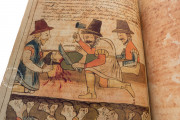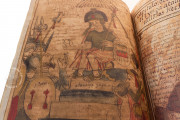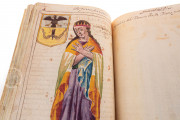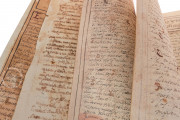Created between around 1580 and 1600 in Peru, the Galvin Murúa employs images and text to describe the history and culture of the Inca before and during the transition from the Andean pre-Columbian period to colonial Peru. The manuscript explains the Incan past to a European audience in pictures, prose, and verse. It contains information on the history, noble genealogy, costumes, customs, social events, religious rituals, laws, and built environment of what became part of the Viceroyalty of Peru in the sixteenth century. The manuscript boasts more than 100 illustrations.
Martín de Murúa, a Mercedarian friar from the Basque region of Spain, is the author and compiler of the book, the earliest illustrated history of Peru. Murúa collaborated with Felipe Guamán Poma de Ayala, an Incan artist, to craft depictions of Incan life and transcribe the lore related to them by inhabitants of the region.
Regal Portraits, Events, and Landscape in Brilliant Color
The Galvin Murúa is especially famous for its brightly colored portraits of Inca royal and noble men and women in native dress. The meticulous rendering of regalia and headgear indicates the complex indigenous textiles of Inca garments and adornments. Likenesses of non-Inca residents are also included. All are painted according to the contemporary European convention of modeling the human form to appear as a three-dimensional presence.
Religious ceremonies, festivals, and legal proceedings are carefully depicted to give a rich visual account of the events and the locales where they took place. Inca temples and civil structures, as well as Spanish colonial buildings, are represented.
Inca Culture in Text and Image
The text is presented in four sections devoted respectively to royalty, the nobility, customs, and cities. Each opening—or pair of facing pages—of the manuscript is devoted to a chapter, with an illustration on the verso and text, neatly outlined in ink, on the adjacent recto. The chapters are of varying length but are always confined to a single page.
A Paradox of the Manuscript's Creation
The text was originally copied by one scribe, writing exclusively on the rectos. Illustrations were supplied by two indigenous artists. An anonymous artist painted thirty illustrations, of which twenty-three survive, mostly toward the front of the manuscript. Murúa added text, mostly to pages of illustrations, before a second artist, Guamán Poma, added 100 more illustrations. Murúa then added text to those illustrations.
The finished product was intended to serve as the exemplar for a printed book, but it never served that function. Instead, it was dismembered and partially rearranged and amplified, before being abandoned. Four of its leaves were repurposed for use in the Getty Murúa and others were lost. The manuscript went, therefore, from being finished to being incomplete.
Travels of the Codex
The manuscript is thought to have traveled to Spain with Martín de Murúa in the early seventeenth century. In the eighteenth century it was in the possession of the Colegio de la Compañía de Jesús, a Jesuit college in Alcalá de Henares, Spain.
The manuscript was kept at a Jesuit exile house in Poyanne, France from 1879 to 1890. It was purchased in the 1950s by an American bookseller, who sold it to John Galvin. It is now in the collection of his son, Seán Galvin.
We have 1 facsimile edition of the manuscript "Galvin Murúa": Códice Murúa facsimile edition, published by Testimonio Compañía Editorial, 2004
Request Info / Price























